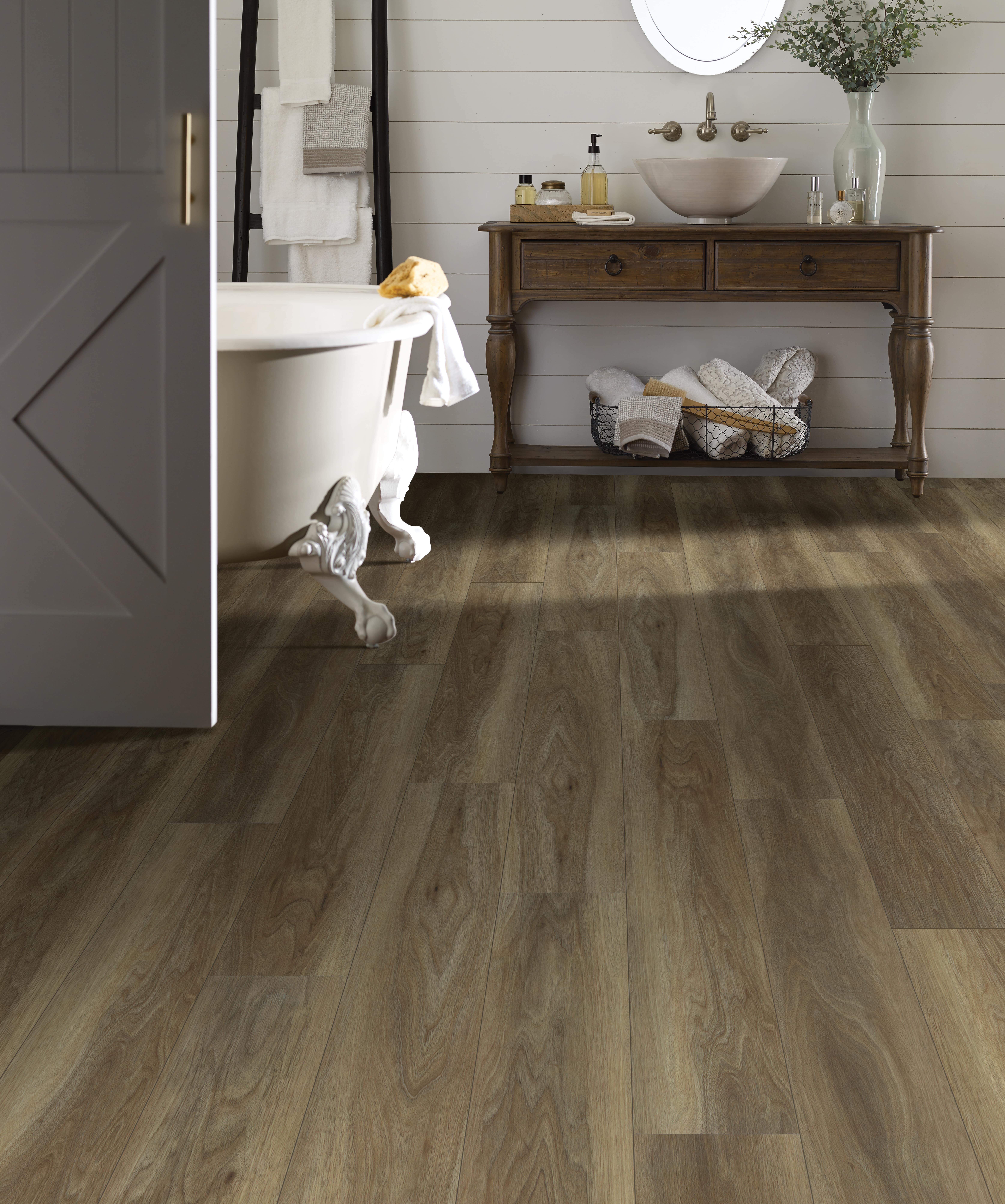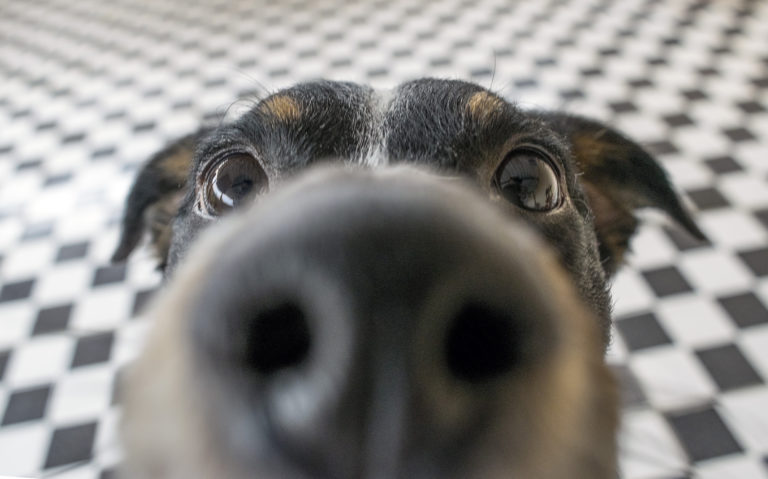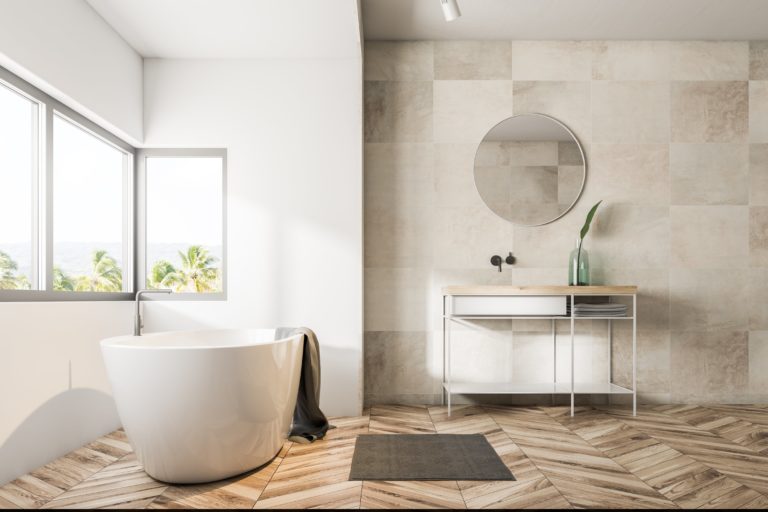This post may contain references or links to products from one or more partners of our parent company and/or subsidiaries of our parent company. For more information, visit this page.
July 24, 2020
Thinking about putting wood floors in a bathroom?
If so, at least one naysayer has probably already tried to steer you toward different types of flooring. And yes, wood flooring in the bathroom is risky. But don’t give up hope just yet! If done correctly, a wood floor bathroom can survive years of steamy showers and bath time splashes.
Below, we’ll go over everything you need to know about installing wood floors in the bathroom, cover which types of wood flooring work best, and show you how to protect your wood floors from moisture.
We’ll also take a deep dive into some specially-crafted water-resistant wood flooring products that you might not know about—as well as some hardwood floor alternatives that can mimic wood, but without the risk of water damage.
👉 If you simply want to know the best hardwood flooring brand for your bathroom, the answer is easy. Proximity Mills carries the only waterproof hardwood that passed our water immersion test.
With that, let’s jump in!
First of All: Can I Put Wood Floors in the Bathroom?
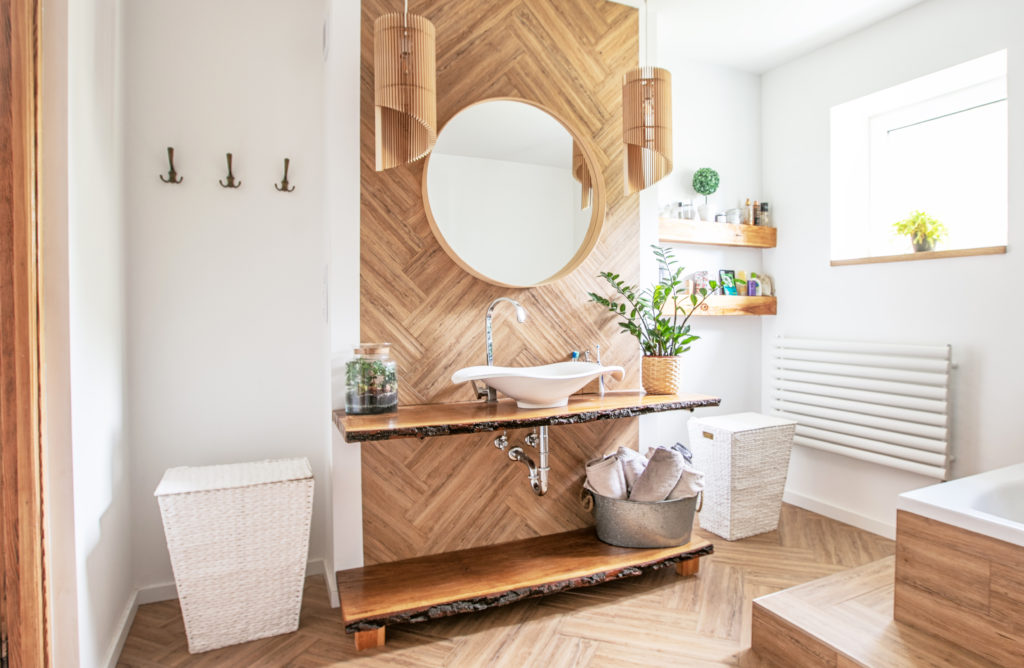
Short answer: yes. But it’s risky if you don’t do it right.
Don’t get us wrong—we love the idea of wood floors in a bathroom. They’re warm; they’re smooth; they’re beautiful. They give bathrooms a fresh, natural feel—turning your boring old water-closet into a restorative spa experience.
But Are Wood Floor Bathrooms a Good Idea?
Well, that all depends on one thing—you.
It’s simple: wood floors rule. They feel great under bare feet. And if you’re thinking about heating wood floors in your home, the bathroom is a high-impact location. Plus, it’s a great trick to make sure your houseguests talk about your awesome home renovations.
But wood floor bathrooms are a high-risk, high-reward situation. Moisture is the enemy of any wood floor, and in the bathroom it’ll have to resist water damage year after year. But if you’re in love with the idea of wood flooring and you have the resources to confront any future issues, we say—go for it!
Just remember: you will need to take special care and budget appropriately
While the wood flooring cost for a bathroom is about the same as any room in your house, you’ll need to budget a little extra for maintenance and repair. If a pipe joint leaks, or the bathtub overfills, you’ll be paying out both the plumber and the contractor!
Wood flooring can warp and buckle over time from moisture. That means you need to stay eagle-eyed to wipe up spills, check for plumbing leaks, and make sure there’s always enough air circulation.
Wood floor bathrooms are like children—needy, expensive, but ultimately rewarding and joyful. And like children, they’re great to have underfoot—but you’ll have to keep a close eye on them while they’re in your house!
Best Brands of 2024
What to Consider Before Installing Wood Floors in a Bathroom
With those warnings in mind, let’s talk about the things you need to consider before installing wood floors in a bathroom.
First of all, there’s no other floor in your house (except maybe your mudroom flooring) that will have to resist as much water as your bathroom flooring. Unfortunately, over time, water damage to a wood floor bathroom is like property tax—unavoidable and annoying.
Here’s what to consider:
Your bathroom floors will see plenty of spills and splashes
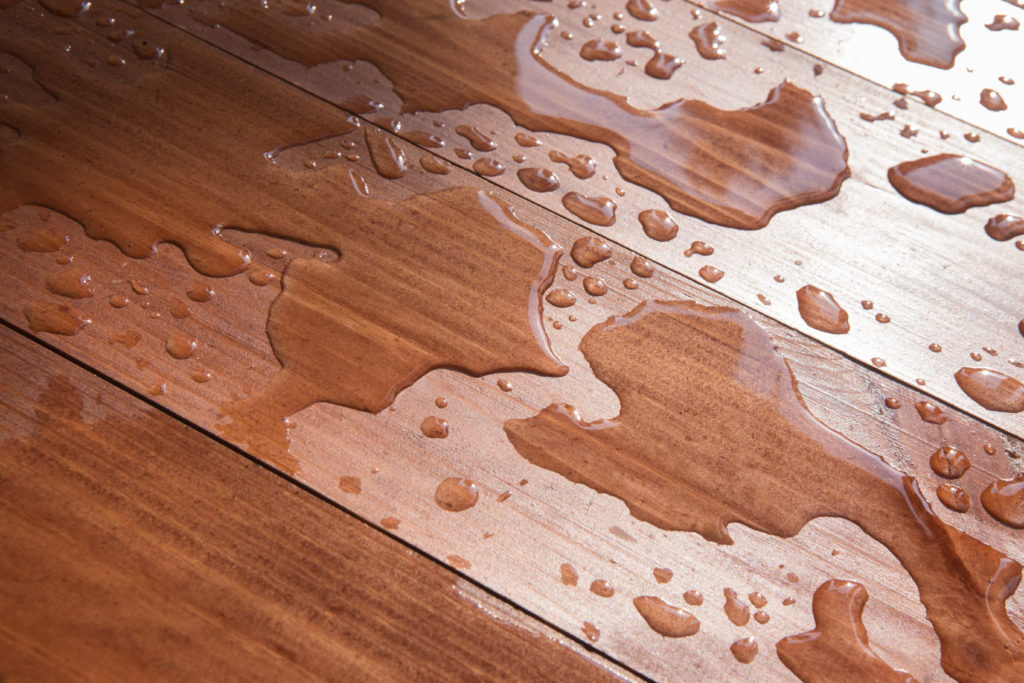
Water will be spilled and splashed on your bathroom floor. It’s unavoidable, and there’s no use pretending it won’t happen every time you use your sink or shower (especially if you have kids).
While small splashes might not seem like much at first, daily splashes over the years can add up to severe damage. This is especially true if they collect in areas you don’t pay much attention to, like in corners or under fixtures.
And it’s not only water you have to worry about. Hair products, especially bleaches and dyes, can do a number on your wood floors. While it’s true you can bleach wooden floors to spot-treat some stains, a fun hair-color change can turn into an annoying refinishing project if you’re not careful with your L’Oréal color creme!
And we can not stress this enough: anywhere water accumulates, wood will swell.
Sloping floors can create puddles
If your bathroom subfloor isn’t perfectly level (and let’s be honest, whose is?), water will slide into low areas and create puddles. If you’re wondering “what is subflooring?”, don’t worry—it’s just the surface below your finished floor.
Subflooring is usually made of plywood or concrete, which both react to moisture. And if the subfloor structure shifts and deforms, it will disrupt your underlayment and upset the slope of the wood floor. Which, of course, means more puddles, and more sloping, and so on.
You’ll have to clean up up after bathing—forever
Luckily, you can identify which areas are lower and likely to collect puddles, but you will need to keep mopping up these same areas—quickly—for the entire life of your floor. Standing water will seep into the seams between your floorboards. Once that happens, you’ll have a whole host of new problems from mold to cracking.
Mold and mildew will eat away at your floor
And speaking of mold: it’s not just gross on last week’s leftovers—mold exposure is toxic to your health and dangerous in your home. Mold and it’s bumbling sidekick, mildew, like to grow in damp, dark areas—like under the hardwood floors in your bathroom.
Mold attacks wood fibers from below, eventually causing wood rot and structural failure. And because mold needs humidity to flourish, a bathroom is the most likely place for it to thrive.
Wood floor bathrooms won’t survive a plumbing disaster
Coming home to a burst pipe and several inches of standing water is a homeowner’s nightmare. Flooding is often a death sentence for a hardwood floor. If your house has a history of plumbing issues, you’re choosing wood at your own risk—so make sure to replace older pipes and fixtures before installing.
There’s no way to prevent leaking through your wood floor
Wood floor bathrooms might have a lot going for them, but one thing they don’t have is a moisture barrier. Even click-together engineered wood isn’t a totally seamless flooring surface. When the floor gets wet, water will leak between the seams and dampen the subflooring below.
Over time the subflooring will deform, and your once-straight floorboards can buckle and heave. And say goodbye to your Pinterest folder of intricate, geometric wood floor patterns—that beautiful herringbone parquet gives moisture far too many points of entry.
But You Can Put Wood Floors in Bathrooms. Here’s How to Do it Right.
Remember: it’s not all doom and gloom! You’ve chosen a harder path, but that doesn’t mean that disaster is inevitable. If you make smart choices now, you can prevent water damage in your wood floor bathroom down the road.
It sounds simple, but consistent maintenance habits will extend the life of your flooring and save you big bucks on future repair bills.
Simple ways to maintain a wood floor bathroom
Proper maintenance is the simplest way to keep your bathroom’s wood flooring in good shape. We said simple; not easy. If you’ve chosen wooden floors, you’ll have to budget more time to clean up after using the bathroom—so no more rushing off to work after your morning shower!
- Wipe up spills and splashes as they occur
- Identify low spots in your floor and always check for puddles
- Lay absorbent bath mats, then hang them to dry
- Keep a squeegee in your shower to move water droplets to the drain
- Check your bathroom fixtures regularly for leaks
- Make sure your bathroom exhaust fan is in good working order
- Keep your bathroom window open during and after you bathe to circulate air
And if your bathroom doesn’t have a window or a good fan, stop right here. An interior bathroom without proper ventilation is not the right fit for any hardwood floor—and yes, we mean it! Without good air circulation, humidity will build up on almost all types of wood flooring.
And most importantly, choose the right type of wood for your bathroom flooring
Now this is the big one. If you choose the right floor product, you can do away with many of the risks we outlined above. For example, products installed as click-together flooring resist moisture better than nail-down or glue-down products. Most of the best hardwood floor brands offer all sorts of click-together floors, so it’s easy to find what you need. And with that in mind:
The Best Types of Wood Flooring for Bathrooms
The best types of wood for bathrooms are durable, naturally water-resistant, and look and feel wonderful. Making the right selection from the endless number of wood flooring types on the market is the most important thing you can do when starting your project. Here’s what you need to know.
Engineered hardwood is a safer bet for bathrooms
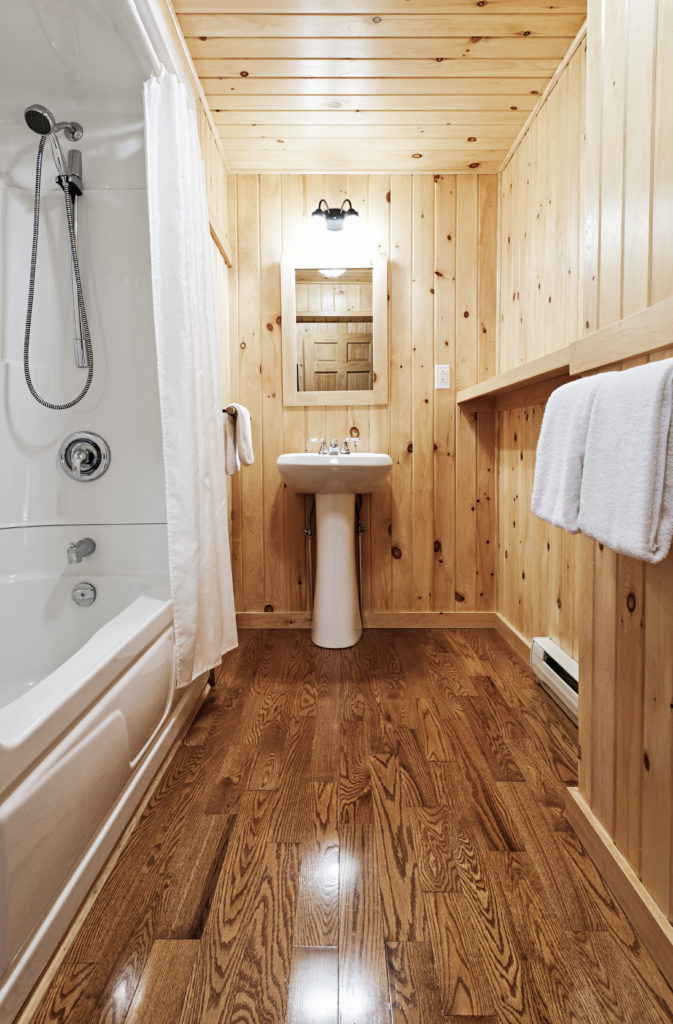
Engineered hardwood flooring is, hands-down, a safer bet for bathrooms than solid hardwood is. The best engineered wood flooring is composed of high-quality plywood, a thin veneer of solid wood, and a durable finish. And while it’s not waterproof per se, it can flex and bend without warping thanks to its plywood core.
When installed, it’s completely indistinguishable from solid hardwood—and much more moisture-resistant to boot. And sure, there are some engineered wood disadvantages, but they mostly have to do with refinishing. And if you’re putting wood floors in a bathroom, the ability to refinish for decades on end probably isn’t a major concern.
A floating installation provides a more water-resistant floor (and it’s easier to replace)
A click-together “floating” floor installation—so-called because the floor “floats” over its subfloor without needing to be nailed or glued down—creates a more seamless surface with less space between boards. And the less space between your floorboards, the more water-resistant your wood floor bathroom.
Plus, click-together boards are much easier to pull up and replace individually, saving you the trouble of redoing the whole bathroom if disaster strikes. Even so, space will remain between your flooring and subflooring—one of the serious disadvantages of floating floors—so make sure to choose a water-resistant underlayment. Tar paper is always a winner!
Additionally: you’re thinking about DIY wood floors, you should definitely lean towards floating floors. They’re easier (and cheaper to install)—one of the reasons that the cost to install engineered hardwood flooring is generally cheaper than the cost to install nail-down or glue-down hardwood floors. The easiest flooring to install is also the most water-resistant? Yes, you read that right. It’s a rare win-win.
Consider using a harder, less porous wood species
When choosing between different types of wood flooring, we’d recommend leaning towards species that rank higher on the Janka Hardness Scale. Harder woods are often less porous. And the more porous your wood, the more vulnerable your wood floor bathroom.
Woods like ipe, maple, and cherry make good bathroom floors, as does mahogany. If you want to go one step further, though, consider using teak flooring. Teak is packed with natural resins and oils that make it naturally water-resistant.
You could always use a softwood like pine flooring, of course, but you’d have to be really careful to keep it sealed at all times. Cedar is another interesting option, as it’s also packed with natural resins that keep it from swelling and shrinking with moisture.
Or, think about doing your wood floor bathroom with cork
Cork might seem like odd choices for a bathroom floor, but it’s surprisingly water-resistant. And its natural, lush pattern can transform any humdrum bathroom into a refreshing, spa-style retreat.
Cork floors are flexible, soft, and hold in heat—great for years of bare feet. Even more importantly, it’s naturally antimicrobial—aka mold and mildew resistant.
Just be sure you’re aware of all the pros and cons of cork flooring before you buy—you’ll need to make sure your cork is regularly well-sealed with a polyurethane finish. And while it’s an attractive option, some down-market cork products (like the cork flooring Lowe’s sells) can be tough to maintain without professional help.
Bamboo flooring is another great (and serene) option
Bamboo flooring can transform also your bathroom into your own personal spa. It’s an ever-more popular choice for stylish homes, and it’s crazy strong to boot. In fact, with a Janka rating that rivals some of the world’s most durable wood flooring, bamboo is seriously tough and water-resistant
If that’s something you’re interested in, check out the pros and cons of engineered bamboo flooring. And if you’re weighing the benefits of bamboo flooring vs. laminate or other synthetic materials, remember that bamboo can be refinished while synthetics can’t.
There are some special waterproof wood flooring products you should look into
These days, advances in technology have led to some pretty amazing flooring products. Some of these are ideal for wood floor bathrooms. We’d recommend checking out RevWood by Mohawk, Hydrotek by Carpet One, and COREtec by USFloors, just to name a few. These products combine real wood with waterproof technology for a truly waterproof wood floor. Pretty cool, no?
Hardwood Floor Alternatives Can Make Wood Floor Bathrooms Easy
Are you hesitant to commit to years of maintenance? Already having doubts about your plumbing? Don’t worry, there are tons of fake wood flooring options that can make wood floor bathrooms easy to install and maintain.
Vinyl plank (also known as LVT) is durable, waterproof, and looks amazing
If a wood floor bathroom isn’t practical for you, don’t fret! Vinyl plank flooring—also known as LVT—is a fantastic alternative. Forget your grandmother’s sheet vinyl flooring; the vinyl plank of today is almost indistinguishable from real hardwood.
On top of that, it’s a waterproof, long-lasting, and extremely scratch-resistant flooring choice. The best types of vinyl flooring come with photorealistic visuals, endless color variations, and even real-wood texturing. If you want to know why people are so crazy about vinyl plank, check out some Pergo Extreme reviews. Pergo is best known for making laminate, but the company’s vinyl offering (Pergo Extreme) is one of the most popular products on the market.
Wood-pattern porcelain tile combines the best of both worlds
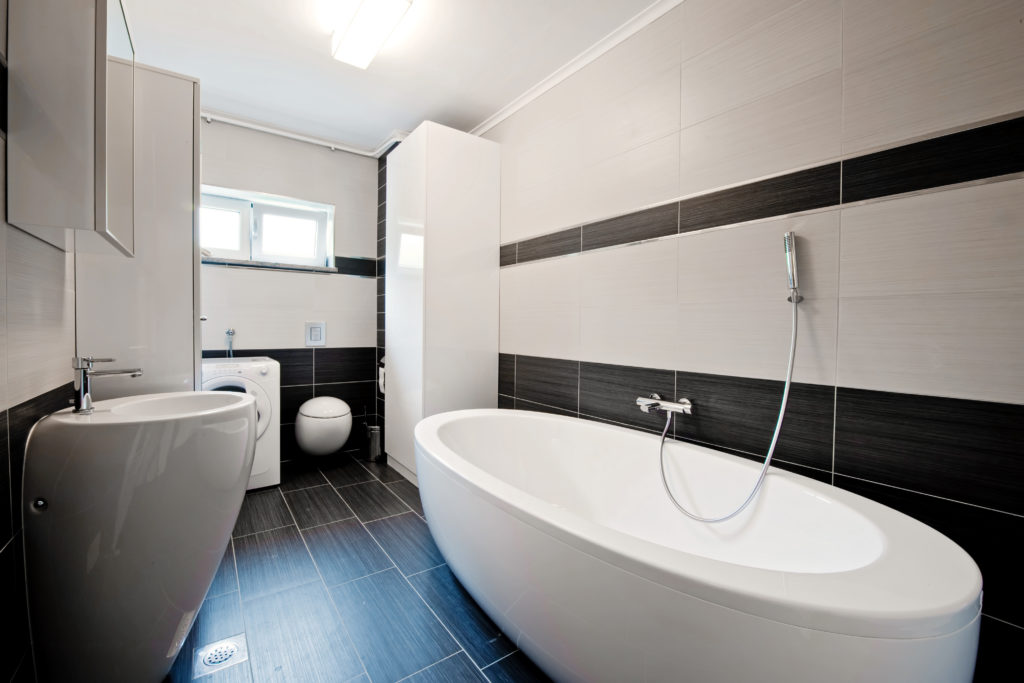
There’s a reason tile is the go-to surface for bathrooms everywhere, from elementary schools to the pages of Architectural Digest. It’s fully waterproof, easy to clean, and extremely durable.
These days, there are tons of wood-look types of tile to choose from. Beech-grain patterns? Check. Faux-mesquite? Check. And don’t even think of looking into the pros and cons of tile vs. laminate for bathrooms—there’s absolutely no competition.
Plus, if you’re worried about the cost of installation (tile is the most expensive flooring to install, on average), take a look at snap-together tile flooring. It’s an easier, DIY-friendly option.
Conclusion
Are wood floor bathrooms easy? Perhaps not. But they can be absolutely lovely! And with that in mind, we hope we’ve given you everything you need in order to decide whether or not a wood floor bathroom is right for you. And if it is, we hope we’ve shown you how to do it the right way.
Now: given all the ins and outs of wood floor bathrooms, we have one more piece of advice for you. Buy your floors from a local flooring store in your area—not from a box store. Local retailers are the ultimate flooring authority. If you want your bathroom floors to turn out right, they’re the ones to talk to.
Not ready just yet? Here’s some more info on all things flooring:
- A Guide to Peel-and-Stick Carpet Tiles (& 9 Reasons They’re Amazing)
- Carpet vs. Laminate: Choosing the Best Floor for You
- How Much Does it Cost to Replace Carpet with Hardwood?
- Why Concrete Flooring That Looks Like Wood is So Darn Cool
- The 8 Best Types of Wood Flooring For Dogs
- The 5 Best Sunroom Flooring Options
- Carpet or Hardwood in Bedrooms: Which is Better?
About The Author

Rose Mraz
July 24, 2020
Rose's career has taken her from small-town teacher to mixologist at several award-winning NYC cocktail bars (and everywhere in between). These days, she plies her craft as an SEO writer specializing in the confluence of wellness, politics, and the service industry.
